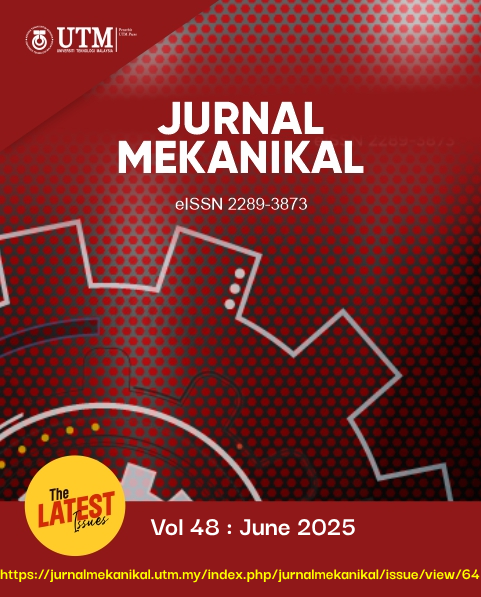The Effects of Taguchi Method and ANOVA in Optimizing Parameters for Enhancing Power Optimization for Electrical Discharge
DOI:
https://doi.org/10.11113/jm.v48.563Keywords:
Taguchi, Power consumption, MRR, WEDM, Stavax.Abstract
Energy consumption in machining process is still a challenge in industries nowadays. A lot of new technologies have been invented to ease the machining and manufacturing process in industry. However, energy optimization in Electrical Discharge Machining (EDM) wirecut is still not fully figured out by manufacturers. The purpose of this experiment was to find the suitable parameter that was consumed for power optimization in EDM wirecut to cut the energy usage in machining process as it would affect the environment. Pulse on (Ton), pulse off (Toff) and cutting voltage (V) with 3 different levels were the variable parameters for this experiment which ranged between (1-16) μs, (6-300) μs and (2-255) V respectively. The outcome result that considered was the total power consumption, and material removal rate (MRR). In this experiment, material known as Stavax ESR (AISI420) was used as the workpiece to achieve the result of power optimization in EDM wirecut. In addition, the Design of Experiment was defined by using Taguchi method. This method was used to reduce the number of experiments, save energy, time and maximize the MRR value. The data analysis and optimization method used for this study was signal-to-noise ratio (S/N ratio) and ANOVA analysis. The most significant variable that was found is the Pulse-ON. The best machining parameters that are generated to produce the best results with minimum value of total power consumption and maximum value of MRR are Pulse ON= 5 μs, Pulse OFF= 52 μs and Voltage =3V.
References
Straka, L., & Kuchta, P. (2021). Quality optimization of the machined surface in terms of electric energy consumption in the WEDM process. MM Science Journal.
Said, M. S. M., et al. (2021). Comparison between Taguchi method and response surface methodology (RSM) in optimizing machining condition. International Conference on Robust Quality Engineering.
Sathiyaraj, S., et al. (2020). Wire electrical discharge machining (WEDM) analysis into MRR and SR on copper alloy. Materials Today: Proceedings, 33, 1079–1084.
Reddy, M. C., et al. (2021). An experimental investigation and optimization of energy consumption and surface defects in wire cut electric discharge machining. Journal of Alloys and Compounds, 861, 158582.
Noor, R. M., Ramli, M. I., Zubair, A. F., Hemdi, A. R., & Kataraki, P. (2022). Optimization of cutting parameters to improve power consumption and material removal rate in high efficiency milling. Journal of Mines, Metals and Fuels, 69(12A), 164.
Soundararajan, R., Ramesh, A., Mohanraj, N., & Parthasarathi, N. (2016). An investigation of material removal rate and surface roughness of squeeze casted A413 alloy on WEDM by multi response optimization using RSM. Journal of Alloys and Compounds, 685, 533–545.
Okolie, J. A., et al. (2021). Modeling and process optimization of hydrothermal gasification for hydrogen production: A comprehensive review. The Journal of Supercritical Fluids, 173, 105199.
Thamizhmanii, S., Saparudin, S., & Hasan, S. (2007). Analyses of surface roughness by turning process using Taguchi method. Journal of Achievements in Materials and Manufacturing Engineering, 20, 503–505.
Nalbant, M., Gökkaya, H., & Sur, G. (2007). Application of Taguchi method in the optimization of cutting parameters for surface roughness in turning. Materials & Design, 28, 1379–1385.
Choudhary, S., Kant, K., & Saini, P. (2013). Analysis of MRR and SR with different electrode for SS 316 on die-sinking EDM using Taguchi technique. Global Journal of Researches in Engineering Mechanical and Mechanics Engineering, 13(3).
Tyagi, Y., et al. (2012). Parametric optimization of CNC drilling machine for mild steel using Taguchi design and single to noise ratio analysis. International Journal of Engineering Science and Technology, 4(8), 3758–3766.
Raju, B. N., Rao, C. M., & Kumar, B. B. A. (2018). Application of signal-to-noise (S/N) ratios and ANOVA for the prediction of optimal designs of multiple performance characteristics. Journal of Industrial Mechanics, 3(2), 1–9.
Abhishek, & Sorout, N. (2020). Multi objective optimization of process parameters on MRR and TWR in EDM for EN 353 material using Grey-Taguchi method. International Journal of Engineering Research & Technology, 9(4), 178–182.
Goyal, S., Kandra, V. S., & Yadav, P. (2016). Experimental study of turning operation and optimization of MRR and surface roughness using Taguchi method. International Journal of Innovative Research in Advanced Engineering, 3, 44–50.
Gupta, M., & Kumar, S. (2015). Investigation of surface roughness and MRR for turning of UD-GFRP using PCA and Taguchi method. Engineering Science and Technology, an International Journal, 18, 70–81.
Chaudhari, S., Nikalje, A. M., & Chaudhari, G. E. (2024). Optimizing material removal rate and surface roughness by utilizing Taguchi and TOPSIS approaches. Interactions, 245, 187.
Downloads
Published
How to Cite
Issue
Section
License
Copyright of articles that appear in Jurnal Mekanikal belongs exclusively to Penerbit Universiti Teknologi Malaysia (Penerbit UTM Press). This copyright covers the rights to reproduce the article, including reprints, electronic reproductions or any other reproductions of similar nature.


















